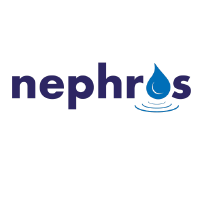Анализ компании Nephros, Inc.
1. Резюме
Плюсы
- Доходность акции за последний год (274.06%) выше чем средняя по сектору (-47.29%).
- Текущий уровень задолженности 12.59% ниже 100% и уменьшился за 5 лет с 21.55%.
Минусы
- Цена (5.23 $) выше справедливой оценки (0.1032 $)
- Дивиденды (0%) меньше среднего по сектору (0.5339%).
- Текущая эффективность компании (ROE=0.8735%) ниже чем в среднем по сектору (ROE=103.63%)
Похожие компании
2. Цена акции и эффективность
2.1. Цена акции
2.3. Рыночная эффективность
| Nephros, Inc. | Healthcare | Индекс | |
|---|---|---|---|
| 7 дней | 6% | -35.1% | 0.9% |
| 90 дней | 59.4% | -47.8% | 8.1% |
| 1 год | 274.1% | -47.3% | 19.3% |
NEPH vs Сектор: Nephros, Inc. превзошел сектор "Healthcare" на 321.35% за последний год.
NEPH vs Рынок: Nephros, Inc. превзошел рынок на 254.75% за последний год.
Стабильная цена: NEPH не является значительно более волатильным чем остальная часть рынка на "NASDAQ" за последние 3 месяца, типичные отклонения в пределах +/- 5% в неделю.
Длительный промежуток: NEPH с недельной волатильностью в 5.27% за прошедший год.
3. Резюме по отчету
5. Фундаментальный анализ
5.1. Цена акции и прогноз цены
Выше справедливой цены: Текущая цена (5.23 $) выше справедливой (0.1032 $).
Цена выше справедливой: Текущая цена (5.23 $) выше справедливой на 98%.
5.2. P/E
P/E vs Сектор: Показатель P/E компании (212.04) выше чем у сектора в целом (-274.25).
P/E vs Рынок: Показатель P/E компании (212.04) выше чем у рынка в целом (-80.5).
5.2.1 P/E Похожие компании
5.3. P/BV
P/BV vs Сектор: Показатель P/BV компании (1.83) ниже чем у сектора в целом (256.7).
P/BV vs Рынок: Показатель P/BV компании (1.83) ниже чем у рынка в целом (51.89).
5.3.1 P/BV Похожие компании
5.5. P/S
P/S vs Сектор: Показатель P/S компании (1.11) ниже чем у сектора в целом (56.99).
P/S vs Рынок: Показатель P/S компании (1.11) ниже чем у рынка в целом (137.42).
5.5.1 P/S Похожие компании
5.5. EV/Ebitda
EV/Ebitda vs Сектор: Показатель EV/Ebitda компании (58.78) выше чем у сектора в целом (12.51).
EV/Ebitda vs Рынок: Показатель EV/Ebitda компании (58.78) выше чем у рынка в целом (-47.95).
6. Доходность
6.1. Доходность и выручка
6.2. Доход на акцию - EPS
6.3. Прошлая доходность Net Income
Тренд доходности: Отрицательный и за последние 5 лет упал на -20.31%.
Ускорение доходности: Доходность за последний год (0%) превышает среднюю доходность за 5 лет (-20.31%).
Доходность vs Сектор: Доходность за последний год (0%) превышает доходность по сектору (-22.73%).
6.4. ROE
ROE vs Сектор: Показатель ROE компании (0.8735%) ниже чем у сектора в целом (103.63%).
ROE vs Рынок: Показатель ROE компании (0.8735%) выше чем у рынка в целом (-10.25%).
6.6. ROA
ROA vs Сектор: Показатель ROA компании (0.6415%) выше чем у сектора в целом (-2.84%).
ROA vs Рынок: Показатель ROA компании (0.6415%) ниже чем у рынка в целом (39.65%).
6.6. ROIC
ROIC vs Сектор: Показатель ROIC компании (0%) ниже чем у сектора в целом (1.17%).
ROIC vs Рынок: Показатель ROIC компании (0%) ниже чем у рынка в целом (8.73%).
8. Дивиденды
8.1. Дивидендная доходность vs Рынок
Низкая див доходность: Дивидендная доходность компании 0% ниже средней по сектору '0.5339%.
8.2. Стабильность и увеличение выплат
Не стабильность дивидендов: Дивидендная доходность компании 0% не стабильно платится на протяжении последних 7 лет, DSI=0.
Слабый рост дивидендов: Дивидендный доход компании 0% слабо или не растет за последние 5 лет. Рост на протяжении только 0 лет.
8.3. Процент выплат
Покрытие дивидендами: Текущие выплаты из доходов (0%) находятся на не комфортном уровне.
Оплатите подписку
Больше функциональности и данных для анализа компаний и портфеля доступно по подписке
На основе источников: porti.ru




